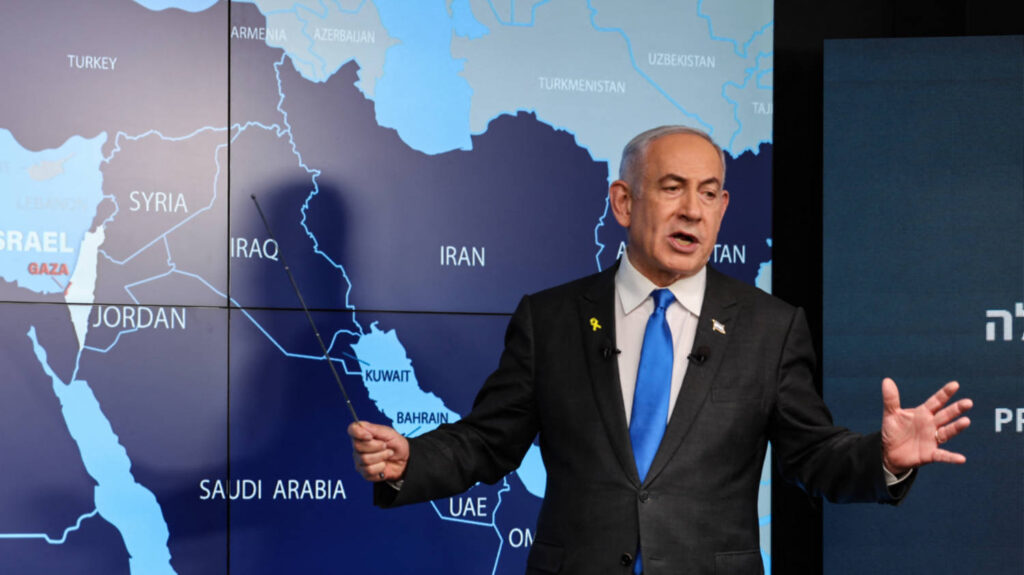Israeli Prime Minister Benjamin Netanyahu said he “very much” identifies with the vision of “Greater Israel” during an interview on Tuesday, as he accepted an amulet of the “promised land” from former right-wing MP Sharon Gal.
His comments have sparked condemnations from many Arab states, which viewed his words as a threat to their sovereign territory.
The concept of “Greater Israel”, which has various interpretations, has long been invoked by ultra-nationalist Israelis.
It is often understood as a vision of territorial expansion to encompass Palestine, Lebanon and Jordan, along with significant parts of Syria, Iraq, Egypt and Saudi Arabia.
It has also been used more narrowly to refer to the territories occupied by Israel in 1967: the Palestinian territories, the Golan Heights in Syria, and Egypt’s Sinai Peninsula.
New MEE newsletter: Jerusalem Dispatch
Sign up to get the latest insights and analysis on
Israel-Palestine, alongside Turkey Unpacked and other MEE newsletters
While Netanyahu’s remarks are recent, the idea of “Greater Israel” is neither new nor clearly defined. For some, it now appears increasingly relevant in light of Israel’s ongoing genocide in Gaza.
When did the idea of Greater Israel begin?
The concept of “Greater Israel” was explored by Theodor Herzl, the father of political Zionism, who wrote in his diaries that the Jewish state should stretch “from the Brook of Egypt to the Euphrates”.
The phrase is taken from Book of Genesis in the Hebrew Bible or Tanakh, where God grants Abraham and his descendants a vast expanse of land stretching “from the Brook of Egypt to the Euphrates.”
Some Israelis refer to a narrower vision mentioned in the Book of Deuteronomy, where God instructs Moses to lead the Israelites in taking possession of Palestine, Lebanon, and parts of Egypt, Jordan and Syria.
Others invoke the Book of Samuel, which describes lands secured by Kings Saul and David, including Palestine, Lebanon, and sections of Jordan and Syria.
For those who hold this belief, the pursuit of “Greater Israel” is not merely political; it is the fulfilment of a divine mandate, a reclamation of land they see as rightfully theirs.
How did the idea of ‘Greater Israel’ return?
Following the establishment of the State of Israel in 1948, the country’s borders remained undefined.
During the Arab-Israel War of 1967, Israel occupied the Gaza Strip and the West Bank, along with the Golan Heights in Syria and the Sinai Peninsula in Egypt.
It was the first major military effort by Israel to expand its territorial control. Sinai was later returned to Egypt as part of a peace treaty, while the Golan Heights were formally annexed.
The war brought renewed attention to the idea of “Greater Israel”, particularly among religious Zionists.
By the late 20th century, the term had become political shorthand, embraced by some Israelis, for the realisation of a historical and religious destiny.
The “Movement for Greater Israel”, a political party founded in the aftermath of the 1967 war, was active until the late 1970s. It advocated retaining the captured territories and settling them with Jewish citizens.
How does the government view the idea?
Since the current Israeli government came to power in 2022, references to “Greater Israel” have become more common.
Last year, Finance Minister Bezalel Smotrich was filmed advocating for the expansion of Israeli borders to include Damascus, the capital of Syria.
He suggested that Israel would gradually grow to encompass not only all Palestinian territories but also parts of Jordan, Lebanon, Egypt, Syria, Iraq and Saudi Arabia.
“It is written that the future of Jerusalem is to expand to Damascus,” he said, invoking the “Greater Israel” ideology.
Smotrich had previously raised similar ideas during a 2023 memorial service for a Likud activist in Paris.
Speaking from a podium adorned with a map of Israel that included Jordan, he stated that “there is no such thing” as the Palestinian people.
Other ministers and MPs have openly advocated “taking land” from Palestinians in the Gaza Strip.
During the ongoing genocide, an Israeli soldier was pictured with a patch, showing a map of “Greater Israel” on his uniform.
Netanyahu’s comments earlier this week came amid the ongoing Israeli military occupation of the West Bank, Gaza Strip and parts of southern Lebanon and southern Syria.


